The Jargon File by Eric S. Raymond (ebook reader android txt) 📕
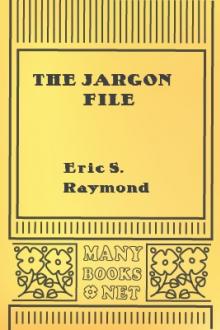
- Author: Eric S. Raymond
- Performer: -
Book online «The Jargon File by Eric S. Raymond (ebook reader android txt) 📕». Author Eric S. Raymond
[1277]PostScript, NeXT, [1278]NeWS, VisiCalc, FrameMaker, TK!solver,
EasyWriter) that have been raised above the ruck of common coinage by
nonstandard capitalization. Too many [1279]marketroid types think this
sort of thing is really cute, even the 2,317th time they do it.
Compare [1280]studlycaps.
Node:B1FF, Next:[1281]BI, Previous:[1282]BiCapitalization, Up:[1283]=
B =
B1FF /bif/ [Usenet] (alt. `BIFF') n.
The most famous [1284]pseudo, and the prototypical [1285]newbie.
Articles from B1FF feature all uppercase letters sprinkled liberally
with bangs, typos, `cute' misspellings (EVRY BUDY LUVS GOOD OLD BIFF
CUZ HE"S A K00L DOOD AN HE RITES REEL AWESUM THINGZ IN CAPITULL LETTRS
LIKE THIS!!!), use (and often misuse) of fragments of [1286]talk mode
abbreviations, a long [1287]sig block (sometimes even a [1288]doubled
sig), and unbounded naivete. B1FF posts articles using his elder
brother's VIC-20. B1FF's location is a mystery, as his articles appear
to come from a variety of sites. However, [1289]BITNET seems to be the
most frequent origin. The theory that B1FF is a denizen of BITNET is
supported by B1FF's (unfortunately invalid) electronic mail address:
B1FF@BIT.NET.
[1993: Now It Can Be Told! My spies inform me that B1FF was originally
created by Joe Talmadge jat@cup.hp.com, also the author of the
infamous and much-plagiarized "Flamer's Bible". The BIFF filter he
wrote was later passed to Richard Sexton, who posted BIFFisms much
more widely. Versions have since been posted for the amusement of the
net at large. See also [1290]Jeff K. --ESR]
Node:BI, Next:[1291]biff, Previous:[1292]B1FF, Up:[1293]= B =
BI //
Common written abbreviation for [1294]Breidbart Index.
Node:biff, Next:[1295]Big Gray Wall, Previous:[1296]BI, Up:[1297]= B =
biff /bif/ vt.
To notify someone of incoming mail. From the BSD utility biff(1),
which was in turn named after a friendly dog who used to chase
frisbees in the halls at UCB while 4.2BSD was in development. There
was a legend that it had a habit of barking whenever the mailman came,
but the author of biff says this is not true. No relation to
[1298]B1FF.
Node:Big Gray Wall, Next:[1299]big iron, Previous:[1300]biff,
Up:[1301]= B =
Big Gray Wall n.
What faces a [1302]VMS user searching for documentation. A full VMS
kit comes on a pallet, the documentation taking up around 15 feet of
shelf space before the addition of layered products such as compilers,
databases, multivendor networking, and programming tools. Recent
(since VMS version 5) documentation comes with gray binders; under VMS
version 4 the binders were orange (`big orange wall'), and under
version 3 they were blue. See [1303]VMS. Often contracted to `Gray
Wall'.
Node:big iron, Next:[1304]Big Red Switch, Previous:[1305]Big Gray
Wall, Up:[1306]= B =
big iron n.
[common] Large, expensive, ultra-fast computers. Used generally of
[1307]number-crunching supercomputers such as Crays, but can include
more conventional big commercial IBMish mainframes. Term of approval;
compare [1308]heavy metal, oppose [1309]dinosaur.
Node:Big Red Switch, Next:[1310]Big Room, Previous:[1311]big iron,
Up:[1312]= B =
Big Red Switch n.
[IBM] The power switch on a computer, esp. the `Emergency Pull' switch
on an IBM [1313]mainframe or the power switch on an IBM PC where it
really is large and red. "This !@%$% [1314]bitty box is hung again;
time to hit the Big Red Switch." Sources at IBM report that, in tune
with the company's passion for [1315]TLAs, this is often abbreviated
as `BRS' (this has also become established on FidoNet and in the PC
[1316]clone world). It is alleged that the emergency pull switch on an
IBM 360/91 actually fired a non-conducting bolt into the main power
feed; the BRSes on more recent mainframes physically drop a block into
place so that they can't be pushed back in. People get fired for
pulling them, especially inappropriately (see also [1317]molly-guard).
Compare [1318]power cycle, [1319]three-finger salute, [1320]120 reset;
see also [1321]scram switch.
Node:Big Room, Next:[1322]big win, Previous:[1323]Big Red Switch,
Up:[1324]= B =
Big Room n.
(Also `Big Blue Room') The extremely large room with the blue ceiling
and intensely bright light (during the day) or black ceiling with lots
of tiny night-lights (during the night) found outside all computer
installations. "He can't come to the phone right now, he's somewhere
out in the Big Room."
Node:big win, Next:[1325]big-endian, Previous:[1326]Big Room,
Up:[1327]= B =
big win n.
[common] Major success. 2. [MIT] Serendipity. "Yes, those twophysicists discovered high-temperature superconductivity in a batch of
ceramic that had been prepared incorrectly according to their
experimental schedule. Small mistake; big win!" See [1328]win big.
Node:big-endian, Next:[1329]bignum, Previous:[1330]big win, Up:[1331]=
B =
big-endian adj.
[common; From Swift's "Gulliver's Travels" via the famous paper "On
Holy Wars and a Plea for Peace" by Danny Cohen, USC/ISI IEN 137, dated
April 1, 1980] 1. Describes a computer architecture in which, within a
given multi-byte numeric representation, the most significant byte has
the lowest address (the word is stored `big-end-first'). Most
processors, including the IBM 370 family, the [1332]PDP-10, the
Motorola microprocessor families, and most of the various RISC designs
are big-endian. Big-endian byte order is also sometimes called
`network order'. See [1333]little-endian, [1334]middle-endian,
[1335]NUXI problem, [1336]swab. 2. An [1337]Internet address the wrong
way round. Most of the world follows the Internet standard and writes
email addresses starting with the name of the computer and ending up
with the name of the country. In the U.K. the Joint Networking Team
had decided to do it the other way round before the Internet domain
standard was established. Most gateway sites have [1338]ad-hockery in
their mailers to handle this, but can still be confused. In
particular, the address me@uk.ac.bris.pys.as could be interpreted in
JANET's big-endian way as one in the U.K. (domain uk) or in the
standard little-endian way as one in the domain as (American Samoa) on
the opposite side of the world.
Node:bignum, Next:[1339]bigot, Previous:[1340]big-endian, Up:[1341]= B
=
bignum /big'nuhm/ n.
[common; orig. from MIT MacLISP] 1. [techspeak] A multiple-precision
computer representation for very large integers. 2. More generally,
any very large number. "Have you ever looked at the United States
Budget? There's bignums for you!" 3. [Stanford] In backgammon, large
numbers on the dice especially a roll of double fives or double sixes
(compare [1342]moby, sense 4). See also [1343]El Camino Bignum.
Sense 1 may require some explanation. Most computer languages provide
a kind of data called `integer', but such computer integers are
usually very limited in size; usually they must be smaller than 2^(31)
(2,147,483,648) or (on a [1344]bitty box) 2^(15) (32,768). If you want
to work with numbers larger than that, you have to use floating-point
numbers, which are usually accurate to only six or seven decimal
places. Computer languages that provide bignums can perform exact
calculations on very large numbers, such as 1000! (the factorial of
1000, which is 1000 times 999 times 998 times ... times 2 times 1).
For example, this value for 1000! was computed by the MacLISP system
using bignums:
40238726007709377354370243392300398571937486421071
46325437999104299385123986290205920442084869694048
00479988610197196058631666872994808558901323829669
94459099742450408707375991882362772718873251977950
59509952761208749754624970436014182780946464962910
56393887437886487337119181045825783647849977012476
63288983595573543251318532395846307555740911426241
74743493475534286465766116677973966688202912073791
43853719588249808126867838374559731746136085379534
52422158659320192809087829730843139284440328123155
86110369768013573042161687476096758713483120254785
89320767169132448426236131412508780208000261683151
02734182797770478463586817016436502415369139828126
48102130927612448963599287051149649754199093422215
66832572080821333186116811553615836546984046708975
60290095053761647584772842188967964624494516076535
34081989013854424879849599533191017233555566021394
50399736280750137837615307127761926849034352625200
01588853514733161170210396817592151090778801939317
81141945452572238655414610628921879602238389714760
88506276862967146674697562911234082439208160153780
88989396451826324367161676217916890977991190375403
12746222899880051954444142820121873617459926429565
81746628302955570299024324153181617210465832036786
90611726015878352075151628422554026517048330422614
39742869330616908979684825901254583271682264580665
26769958652682272807075781391858178889652208164348
34482599326604336766017699961283186078838615027946
59551311565520360939881806121385586003014356945272
24206344631797460594682573103790084024432438465657
24501440282188525247093519062092902313649327349756
55139587205596542287497740114133469627154228458623
77387538230483865688976461927383814900140767310446
64025989949022222176590433990188601856652648506179
97023561938970178600408118897299183110211712298459
01641921068884387121855646124960798722908519296819
37238864261483965738229112312502418664935314397013
74285319266498753372189406942814341185201580141233
44828015051399694290153483077644569099073152433278
28826986460278986432113908350621709500259738986355
42771967428222487575867657523442202075736305694988
25087968928162753848863396909959826280956121450994
87170124451646126037902930912088908694202851064018
21543994571568059418727489980942547421735824010636
77404595741785160829230135358081840096996372524230
56085590370062427124341690900415369010593398383577
79394109700277534720000000000000000000000000000000
00000000000000000000000000000000000000000000000000
00000000000000000000000000000000000000000000000000
00000000000000000000000000000000000000000000000000
00000000000000000000000000000000000000000000000000
000000000000000000.
Node:bigot, Next:[1345]bit, Previous:[1346]bignum, Up:[1347]= B =
bigot n.
[common] A person who is religiously attached to a particular
computer, language, operating system, editor, or other tool (see
[1348]religious issues). Usually found with a specifier; thus, `cray
bigot', ITS bigot',APL bigot', VMS bigot',Berkeley bigot'. Real
bigots can be distinguished from mere partisans or zealots by the fact
that they refuse to learn alternatives even when the march of time
and/or technology is threatening to obsolete the favored tool. It is
truly said "You can tell a bigot, but you can't tell him much."
Compare [1349]weenie, [1350]Amiga Persecution Complex.
Node:bit, Next:[1351]bit bang, Previous:[1352]bigot, Up:[1353]= B =
bit n.
[from the mainstream meaning and `Binary digIT'] 1. [techspeak] The
unit of information; the amount of information obtained by asking a
yes-or-no question for which the two outcomes are equally probable. 2.
[techspeak] A computational quantity that can take on one of two
values, such as true and false or 0 and 1. 3. A mental flag: a
reminder that something should be done eventually. "I have a bit set
for you." (I haven't seen you for a while, and I'm supposed to tell or
ask you something.) 4. More generally, a (possibly incorrect) mental
state of belief. "I have a bit set that says that you were the last
guy to hack on EMACS." (Meaning "I think you were the last guy to hack
on EMACS, and what I am about to say is predicated on this, so please
stop me if this isn't true.")
"I just need one bit from you" is a polite way of indicating that you
intend only a short interruption for a question that can presumably be
answered yes or no.
A bit is said to be set' if its value is true or 1, andreset' or
`clear' if its value is false or 0. One speaks of setting and clearing
bits. To [1354]toggle or `invert' a bit is to change it, either from 0
to 1 or from 1 to 0. See also [1355]flag, [1356]trit, [1357]mode bit.
The term `bit' first appeared in print in the computer-science sense
in a 1948 paper by information theorist Claude Shannon, and was there
credited to the early computer scientist John Tukey (who also seems to
have coined the term software'). Tukey records thatbit' evolved
over a lunch table as a handier alternative to bigit' orbinit', at
a conference in the winter of 1943-44.
Node:bit bang, Next:[1358]bit bashing, Previous:[1359]bit, Up:[1360]=
B =
bit bang n.
Transmission of data on a serial line, when accomplished by rapidly
tweaking a single output bit, in software, at the appropriate times.
The technique is a simple loop with eight OUT and SHIFT instruction
pairs for each byte. Input is more interesting. And full duplex (doing
input and output at the same time) is one way to separate the real
hackers from the [1361]wannabees.
Bit bang was used on certain early models of Prime computers,
presumably when UARTs were too expensive, and on archaic Z80 micros
with a Zilog PIO but no SIO. In an interesting instance of the
[1362]cycle of reincarnation, this technique returned to use in the
early 1990s on some RISC architectures because it consumes such an
infinitesimal part of the processor that it actually makes sense not
to have a UART. Compare [1363]cycle of reincarnation.
Node:bit bashing, Next:[1364]bit bucket, Previous:[1365]bit bang,
Up:[1366]= B =
bit bashing n.
(alt. `bit diddling' or [1367]bit twiddling) Term used to describe any
of several kinds of low-level programming characterized by
manipulation of [1368]bit, [1369]flag, [1370]nybble, and other
smaller-than-character-sized pieces of data; these include low-level
device control, encryption algorithms, checksum and error-correcting
codes, hash functions, some flavors of graphics programming (see
[1371]bitblt), and assembler/compiler code generation. May connote
either tedium or a real technical challenge (more usually the former).
"The command decoding for the new tape driver looks pretty solid but
the bit-bashing for the control registers still has bugs." See also
[1372]bit bang, [1373]mode bit.
Node:bit bucket, Next:[1374]bit decay, Previous:[1375]bit bashing,
Up:[1376]= B =
bit bucket n.
[very common] 1. The universal data sink (originally, the mythical
receptacle used to catch bits when they fall off the end of a register
during a shift instruction). Discarded, lost, or destroyed data is
said to have `gone to the bit bucket'. On [1377]Unix, often used for
[1378]/dev/null. Sometimes amplified as `the Great Bit Bucket in the
Sky'. 2. The place where all lost mail and news messages eventually
go. The selection is performed according to [1379]Finagle's Law;
important mail is much more likely to end up in the bit bucket than
junk mail, which has an almost 100% probability of getting delivered.
Routing to the bit bucket is automatically performed by mail-transfer
agents, news systems, and the lower layers of the network. 3. The
ideal location for all
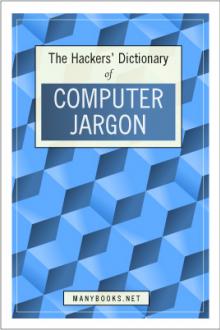

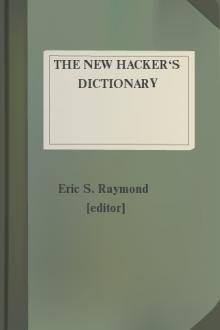
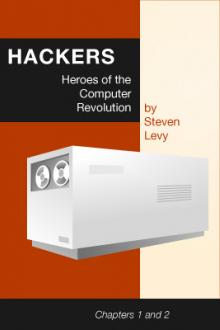
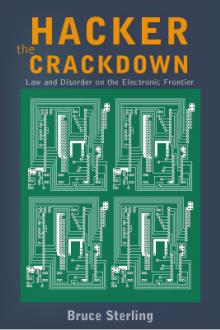
Comments (0)